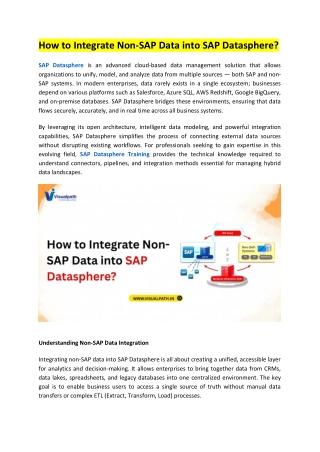
0 likes | 2 Vues
Transform your career in data management with Visualpathu2019s industry-focused training programs. Advance your expertise with SAP Datasphere Training In Hyderabad to master data integration, modeling, and cloud analytics. Join our SAP Datasphere Course for hands-on projects, live labs, expert mentorship, and globally recognized certification. Call 91-7032290546 today.<br>visit: https://www.visualpath.in/sap-datasphere-training-online.html<br>WhatsApp: https://wa.me/c/917032290546<br>Blog link: https://visualpathblogs.com/sap-datasphere<br>

E N D
How to Integrate Non-SAP Data into SAP Datasphere? SAP Datasphere is an advanced cloud-based data management solution that allows organizations to unify, model, and analyze data from multiple sources — both SAP and non- SAP systems. In modern enterprises, data rarely exists in a single ecosystem; businesses depend on various platforms such as Salesforce, Azure SQL, AWS Redshift, Google BigQuery, and on-premise databases. SAP Datasphere bridges these environments, ensuring that data flows securely, accurately, and in real time across all business systems. By leveraging its open architecture, intelligent data modeling, and powerful integration capabilities, SAP Datasphere simplifies the process of connecting external data sources without disrupting existing workflows. For professionals seeking to gain expertise in this evolving field, SAP Datasphere Training provides the technical knowledge required to understand connectors, pipelines, and integration methods essential for managing hybrid data landscapes. Understanding Non-SAP Data Integration Integrating non-SAP data into SAP Datasphere is all about creating a unified, accessible layer for analytics and decision-making. It allows enterprises to bring together data from CRMs, data lakes, spreadsheets, and legacy databases into one centralized environment. The key goal is to enable business users to access a single source of truth without manual data transfers or complex ETL (Extract, Transform, Load) processes.
SAP Datasphere achieves this by combining federation and replication techniques: Data Federation: Connects to external data sources in real time without copying or duplicating data. Data Replication: Copies and syncs data into SAP Datasphere when real-time access isn’t feasible. This hybrid approach ensures flexibility — users can work with live data for fast analytics or maintain replicated data for high-performance reporting. Connectivity and Integration Methods SAP Datasphere provides multiple integration options to link non-SAP sources: 1.Built-in Connectors: It comes with prebuilt connectors for popular systems such as Salesforce, Google BigQuery, Azure Synapse, Amazon S3, and Oracle Database. These connectors simplify authentication, data mapping, and synchronization with minimal configuration. 2.ODBC and JDBC Interfaces: For databases without native connectors, ODBC and JDBC interfaces allow seamless integration through standard SQL connectivity. 3.SAP Data Intelligence Integration: SAP Datasphere works natively with SAP Data Intelligence, enabling complex data orchestration and transformation workflows that include both SAP and non-SAP datasets. 4.APIs and REST Services: Custom-built APIs and REST services allow data exchange with proprietary or third- party systems. This is ideal for organizations that maintain in-house applications or specialized data platforms. 5.File-Based Integration: CSV, JSON, and XML files can be uploaded or scheduled for import, making it easier to bring data from smaller or legacy systems. Each of these integration methods ensures that enterprises maintain a consistent data flow, enabling advanced analytics through tools like SAP Analytics Cloud or external BI platforms. Professionals learning through SAP Datasphere Online Training often work on real-world scenarios such as integrating CRM data from Salesforce or customer feedback from Google Sheets into Datasphere, helping them understand how these connections power enterprise reporting.
Steps to Integrate Non-SAP Data Here’s a simplified process for integrating non-SAP sources into SAP Datasphere: 1.Define Data Source: Identify the system (for example, Salesforce, AWS, or SQL Server) and determine whether you need real-time or batch-based data. 2.Set Up a Connection: Use the connection manager in SAP Datasphere to create a link to your external data source. Configure authentication parameters like OAuth or API keys. 3.Import Metadata: Pull in metadata (table structures, fields, and relationships) to model how the data will appear inside SAP Datasphere. 4.Data Mapping: Map non-SAP fields to SAP Datasphere models for consistency and accuracy. 5.Build Data Flows: Use the graphical interface to design data flows — define how data moves, transforms, and loads. 6.Schedule or Trigger Data Loads: Automate synchronization with scheduled or event-based triggers for continuous updates. 7.Validate and Monitor: Validate records after integration and use SAP Datasphere’s monitoring dashboards to track performance and data quality. By following these steps, organizations ensure a smooth and efficient data unification process that supports accurate analytics and real-time decision-making. Benefits of Non-SAP Data Integration Unified Data View: Gain a holistic view of the enterprise by combining SAP and non- SAP data. Faster Decision-Making: Enable real-time analytics with live connections. Cost Efficiency: Reduce data duplication and maintenance efforts. Scalability: Add new data sources easily as business requirements evolve. Enhanced Collaboration: Give departments access to shared, trusted data for better insights. These advantages demonstrate why SAP Datasphere is becoming a central element of enterprise data strategies, especially for organizations adopting multi-cloud and hybrid
environments. Learners exploring these capabilities through an SAP Datasphere Course In Hyderabad can gain hands-on experience in real-time integration, data governance, and semantic modeling — preparing them for data-driven enterprise roles. Conclusion Integrating non-SAP data into SAP Datasphere empowers businesses to unlock the full potential of their data ecosystem. Whether connecting modern cloud platforms or traditional databases, Datasphere provides a flexible and secure framework that promotes transparency, agility, and faster decision-making. By leveraging its prebuilt connectors, API integrations, and intelligent modeling tools, enterprises can create a single, unified data fabric that supports advanced analytics and strategic innovation. As organizations continue to expand their digital ecosystems, SAP Datasphere stands out as a powerful solution for unifying diverse data landscapes into one cohesive platform. TRENDING COURSES: AWS Data Engineering, GCP Data Engineering, Oracle Integration Cloud Visualpath Visualpath is the Leading and Best Software Online Training Institute in Hyderabad is the Leading and Best Software Online Training Institute in Hyderabad. . For More Information about Best For More Information about Best SAP Datasphere Contact Call/WhatsApp: Contact Call/WhatsApp: +91 +91- -7032290546 7032290546 Visit: Visit: https://www.visualpath.in/sap-datasphere-training-online.html